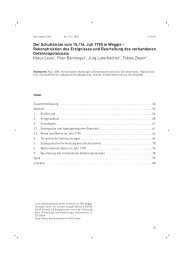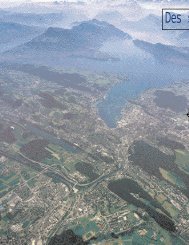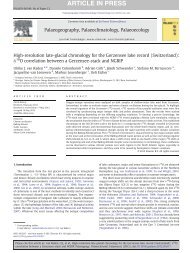Lake Sediments as Archives of Recurrence Rates and ... - Eawag
Lake Sediments as Archives of Recurrence Rates and ... - Eawag
Lake Sediments as Archives of Recurrence Rates and ... - Eawag
Create successful ePaper yourself
Turn your PDF publications into a flip-book with our unique Google optimized e-Paper software.
<strong>Lake</strong> <strong>Sediments</strong> <strong>as</strong> <strong>Archives</strong> <strong>of</strong> <strong>Recurrence</strong> <strong>Rates</strong> <strong>and</strong> Intensities <strong>of</strong> P<strong>as</strong>t Flood Events 231<br />
4. Coring ability to recover desired time interval<br />
The sedimentation rate <strong>of</strong> a lacustrine archive can vary strongly between the<br />
different lake systems. In particular, the contribution <strong>of</strong> the general detrital influx<br />
to the total sedimentation can make a large difference to total sediment thickness.<br />
St<strong>and</strong>ard coring techniques with various piston-coring methods are capable <strong>of</strong><br />
reaching 20 m sub lake-floor depth, so that sediment thickness for the desired<br />
time interval should not exceed this range. Deeper core recovery can otherwise<br />
only be reached by complex <strong>and</strong> expensive commercial drilling operations. If a<br />
complete Holocene section is the target, rather small lakes with little inflow are<br />
ideal (Gilli et al. 2003; Theiler 2003). Larger perialpine lakes (e.g. <strong>Lake</strong> Uri, <strong>Lake</strong><br />
Brienz, both Switzerl<strong>and</strong>) have substantially larger sedimentation rates reaching<br />
values <strong>of</strong> up to 10 m per 1,000 years (Girardclos et al. 2007; Siegenthaler <strong>and</strong><br />
Sturm 1991).<br />
3 The Signature <strong>of</strong> Flood Events in the Lacustrine Archive<br />
A key step in palae<strong>of</strong>lood studies using lake sediments is the secure identification <strong>of</strong><br />
detrital layers <strong>as</strong> the result <strong>of</strong> a flood event. As the sedimentation <strong>of</strong> each lake system<br />
is influenced by a large variety <strong>of</strong> different factors, we can only discuss general rules<br />
here, which clearly need to be adapted to each individual lacustrine system (Mulder<br />
<strong>and</strong> Chapron 2011). Ideally, the detrital layers should sharply contr<strong>as</strong>t in terms <strong>of</strong><br />
sedimentology <strong>and</strong> geochemical composition with the regular background sediment<br />
(Sletten et al. 2003). In these c<strong>as</strong>es, the detrital layer can be <strong>of</strong>ten identified by<br />
visual observation even at the millimetre scale, a process, which can be supported<br />
by image analysis (e.g. Rodbell et al. 1999)(Fig.3).<br />
The sedimentology <strong>of</strong> the flood layers is characterized by a near pure terrestrial<br />
mineralogical composition <strong>and</strong> consequently a low organic content. The underflowrelated<br />
depositional processes (see part “Depositional processes in lakes”) cause<br />
a fining-upward grain-size pattern with sometimes an inverse graded b<strong>as</strong>e from<br />
temporal waxing <strong>of</strong> the flood-related run<strong>of</strong>f. The top part <strong>of</strong> the detrital layer<br />
consists <strong>of</strong> the finest particles <strong>and</strong> h<strong>as</strong> <strong>of</strong>ten a distinctive light colour (Fig. 3),<br />
commonly referred <strong>as</strong> ‘clay cap’. Sometimes, several stacked graded intervals<br />
within the same flood layer point towards multiple water discharge peaks (Fig. 2). In<br />
rather rare c<strong>as</strong>es, the b<strong>as</strong>e <strong>of</strong> flood layers consists <strong>of</strong> aquatic macrophytes (Gilli et al.<br />
2003), which were entrained by the underflow. On the b<strong>as</strong>is <strong>of</strong> the characteristics <strong>of</strong><br />
these detrital layers, previous studies applied, next to visual observations, one or<br />
a combination <strong>of</strong> several proxies to identify such layers. The three most common<br />
applied proxies are (1) grain size, (2) total organic carbon (<strong>of</strong>ten expressed <strong>as</strong> loss<br />
<strong>of</strong> ignition, i.e. LOI), <strong>and</strong> (3) magnetic susceptibility. These proxies are interpreted<br />
<strong>as</strong> follows:<br />
1. Grain size: Grain-size me<strong>as</strong>urements are almost routinely used to confirm a<br />
fining-upward gradation overlying a coarser b<strong>as</strong>e (Fig. 2). Recently, Parris








